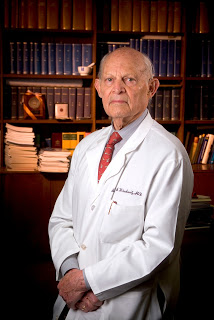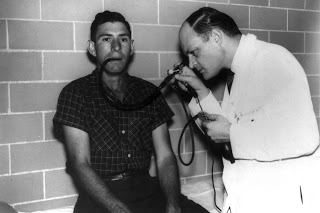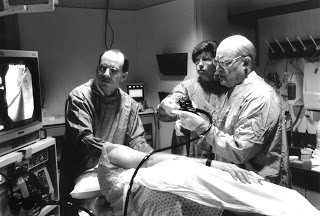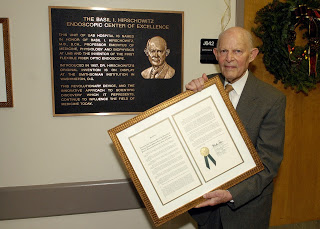 UAB physician Basil I. Hirschowitz, M.D., Ph.D., professor emeritus of medicine, physiology and biophysics at UAB, the medical pioneer who invented the first fiber-optic endoscope that became the standard for visualizing and treating virtually every cavity in the body, passed away January 19, 2013, at the age of 87.
UAB physician Basil I. Hirschowitz, M.D., Ph.D., professor emeritus of medicine, physiology and biophysics at UAB, the medical pioneer who invented the first fiber-optic endoscope that became the standard for visualizing and treating virtually every cavity in the body, passed away January 19, 2013, at the age of 87.A gifted and caring physician, research scientist and teacher, Hirschowitz dedicated his career to the study of physiology, pharmacology and diseases of the upper GI tract, and he published more than 350 papers; many related to ulcer disease. Hirschowitz’s major research initiatives throughout his career involved the normal gastric functions and pathophysiology of acid-peptic diseases such as peptic ulcer, reflux and, particularly, Zollinger-Ellison Syndrome. His career achievements include leadership in clinical trials that were the forerunners to new pharmaceutical treatments in gastroenterology. Those trials paved the way for widespread use of medications known today as Pepcid, Prilosec and Nexium.
The most significant mark on medicine Hirschowitz made was in 1957, when he, along with colleagues Larry Curtis and C. Wilbur Peters, created the first fully flexible fiberoptic endoscope while on the medical school faculty at the University of Michigan. The trio developed a technique for coating and bundling hair-thin glass fibers in such a way as to allow viewing over long distances and around bends. This gave an illuminated and unobstructed view inside hollow organs such as the esophagus, stomach and colon, and provided the means for minimally invasive surgery. Hirschowitz tested the prototype by swallowing it himself.
 He brought the revolutionary device in 1959 to Birmingham and joined the UAB faculty as associate professor of medicine and founder of the Division of Gastroenterology (now the Division of Gastroenterology and Hepatology), a post he held for 29 years. While at UAB, Hirschowitz worked on perfecting the new endoscope and utilized it regularly for the first time at UAB Hospital. The first endoscopy unit at UAB was located in a small room adjacent to Hirschowitz’s office. Patients would be rolled across 19th Street to the unit, rain or shine. After the procedure, patients would recover in the bed in which they were rolled to the endoscopy unit.
He brought the revolutionary device in 1959 to Birmingham and joined the UAB faculty as associate professor of medicine and founder of the Division of Gastroenterology (now the Division of Gastroenterology and Hepatology), a post he held for 29 years. While at UAB, Hirschowitz worked on perfecting the new endoscope and utilized it regularly for the first time at UAB Hospital. The first endoscopy unit at UAB was located in a small room adjacent to Hirschowitz’s office. Patients would be rolled across 19th Street to the unit, rain or shine. After the procedure, patients would recover in the bed in which they were rolled to the endoscopy unit.In the half-century since, Hirschowitz’s endoscope has completely changed how physicians around the world diagnose and treat patients, becoming the standard tool for visualizing virtually every body cavity. It is arguably one of the most important developments of the 20th century. The original instrument resides in the permanent collection of the Smithsonian.
“Essentially Basil created what gastroenterology is today,” said C. Mel Wilcox, M.D., director of the UAB Division of Gastroenterology and Hepatology. “Think of the countless lives that have been both helped and saved by this wonderful device he and his colleagues dreamed about and then brought to fruition.”
 Hirschowitz retired as professor in the UAB Department of Medicine's Division of Gastroenterology and Hepatology in 1995 after 36 years of service. Until recently, he continued to work actively as professor emeritus in the UAB School of Medicine, focusing on clinical practice and research. He was named Distinguished Faculty Lecturer in 1988 and Professor Emeritus in 1996.
Hirschowitz retired as professor in the UAB Department of Medicine's Division of Gastroenterology and Hepatology in 1995 after 36 years of service. Until recently, he continued to work actively as professor emeritus in the UAB School of Medicine, focusing on clinical practice and research. He was named Distinguished Faculty Lecturer in 1988 and Professor Emeritus in 1996.In 2004, Hirschowitz was presented an honorary Doctor of Medicine by the Sahlgrenska Academy of Goteborg University, Sweden. He was named a Fellow in the Royal Society of Medicine, London, and was elected to the Alabama Academy of Honor. The Basil I. Hirschowitz Endowed Chair in Gastroenterology was established at UAB in 1997, and upon his retirement in 2008, he was awarded the UAB President’s Medal. Most recently, the board of trustees of The University of Alabama System passed a resolution naming the new endoscopy unit in UAB Hospital the Basil I. Hirschowitz Endoscopic Center of Excellence.
Hirschowitz’s leadership in gastroenterology garnered several meritorious honors, including a Nobel Prize nomination. He was also the recipient of the General Motors Cancer Research Foundation Charles F. Kettering Prize, the Julius Friedenwald Medal from the American Gastroenterological Association, the Schindler Medal from the American Society for Gastrointestinal Endoscopy, the Distinguished Scientist Award from the American College of Gastroenterology, the Castle Connolly National Physician of the Year Award for Lifetime Achievement and the Laureate Award of the American College of Physicians, for which he also was elected Master.
 A native of Bethal, South Africa, Hirschowitz earned three degrees at the University of Witwatersrand in Johannesburg, including the equivalent of the American degrees of M.D. and Ph.D. In 1950, he left South Africa to work in London; first at the Royal Postgraduate Medical School and then at the Central Middlesex Hospital. In 1953, he earned admittance as a member of the Royal College of Physicians in Edinburgh and London. He later was awarded Fellowship in both.
A native of Bethal, South Africa, Hirschowitz earned three degrees at the University of Witwatersrand in Johannesburg, including the equivalent of the American degrees of M.D. and Ph.D. In 1950, he left South Africa to work in London; first at the Royal Postgraduate Medical School and then at the Central Middlesex Hospital. In 1953, he earned admittance as a member of the Royal College of Physicians in Edinburgh and London. He later was awarded Fellowship in both.In addition to his love of medicine and science, Hirschowitz was an avid photographer and a keen gardener, with a particular love for cultivating roses. He was a collector of African art, geological specimens and stamps. In 1992, he was named a Fellow of the Royal Philatelic Society of London.
Hirschowitz is survived by his wife of fifty-five years, Barbara, his children David Hirschowitz, Kaaren Hirschowitz Engel, Dr. Edward Hirschowitz (Alison), Vanessa Hirschowitz (Nick Kouchoukos) and seven grandchildren: Zoe, Simon and Iris Engel; Maxwell, Sophie and Sydney Hirschowitz; and Alexander Kouchoukos.